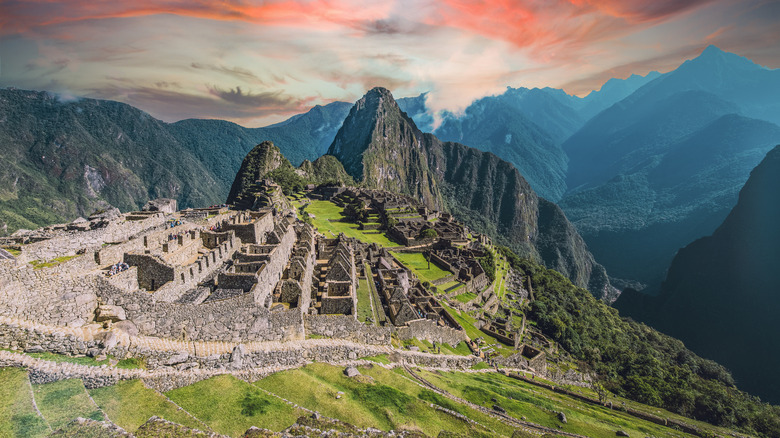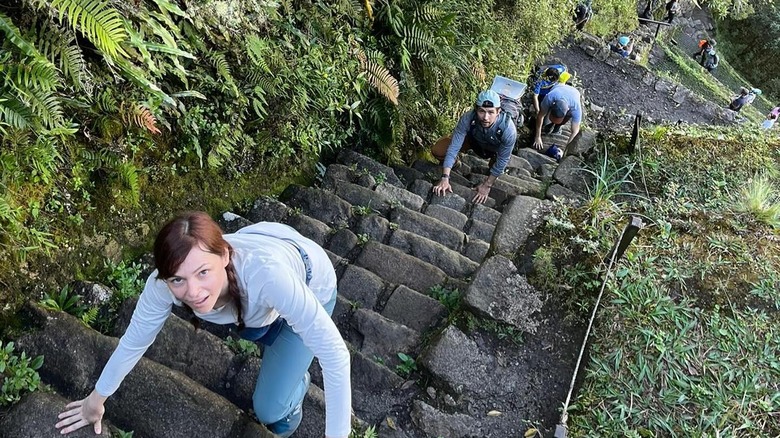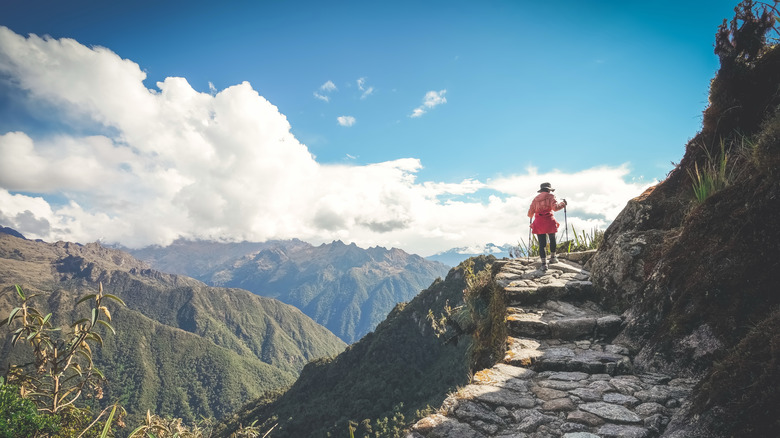Why One Of South America's Most Iconic Trails Is Known As The 'Hike Of Death'
Hiking the Inca Trail to Machu Picchu is a bucket list adventure for many travelers, and that was certainly the case when I did it. What I didn't expect, however, was that the highlight of the 3-day trek would be an experience I added almost as an afterthought: The so-called "Stairs of Death" up Huayna Picchu. In every postcard view of the ancient Inca city of Machu Picchu you've ever seen, Huayna Picchu is there in the background, a tall, bullet-shaped mountain so soaringly vertical you wouldn't think it climbable. And it wouldn't be, had the ancient Incas not painstakingly constructed 2,100 stone stairs in 1450 A.D., some carved and some built of stacked stones, with every step, flight, and landing uniquely contoured to the mountain.
Flight after flight, they climb at dizzying angles, leading all the way to the top. For comparison, there are only 1,800 stair steps to the Empire State Building's 102nd floor observation deck, where you look down on taxi cabs swarming midtown like little yellow ants. Given its ominous name for its imposing and intimidating nature, Huayna Picchu gives you that vertiginous view, but it's across a Peruvian jungle, through the mists of time, and into antiquity.
But despite that dramatic name, it's important to point out that no tourist has yet to die climbing it.
The hike up Huayna Picchu
You'll need a reservation for Huayna Picchu, but that's a good thing: You don't want to navigate these steps in a crowd, in part for safety, but also because the pretty way they curve and unfurl before you is what you're here to see. So, plan ahead to be one of the 400 permitted to climb daily.
Even if, like me, you're one of the 28% of people who fear heights, the Stairs of Death are not as scary as you anticipate. In some places, they are so steep you'll instinctively reach your hands out to help you climb, but then you'll feel remarkably stable, with solid hand-holds, and firm footing. Later, you will reach some actual ladders — one reason not to bring a bulky pack: Climbing or descending a ladder, you don't want anything heavy pulling your center of gravity backward. On your way down, don't hesitate to turn around and descend the steep sections backward, ladder-style; it's a less tippy feeling and easier on your knees.
When I climbed Huayna Picchu and looked down at the lost city of Machu Picchu from the top, I felt a glimmer of what it must have been like to be an ancient mountain-dweller, whose gorgeous, looping "highways" were so breathtakingly elegant that people like me would make pilgrimages to them years later. The Inca really were on top of the world.
Getting to Machu Picchu and Huayna Picchu on the Inca Trail
You can always take the train from Cuzco straight to Machu Picchu, or even get there as part of a luxury yacht cruise package that includes the Galapagos. But just as you'll only ever have one first kiss, you'll only see the ancient city for the first time once. And ideally, that should be as you crest a hill and pass through the Sun Gate at sunrise, at the end of three days on the magical Inca Trail.
I hiked the 25-mile Inca Trail and climbed Huayna Picchu with non-hiker friends, and everybody made it just fine. We hired a local Quechua porter recommended by our outfitter to carry some of our rented gear, a great way to support the indigenous economy. We huffed and puffed — with passes as high as 13,800-feet, the altitude is humbling however fit you are — and I was grateful not to have a heavy pack to carry. Yet the distances we covered were so trivial to our extraordinary porter that he would set us up each night and run home to his family, then run back to us the next morning.
Take a couple of days to acclimate to the altitude when you reach the Andes (we flew into Cuzco), and definitely make time to visit the incredible man-made islands of Lake Titicaca.


